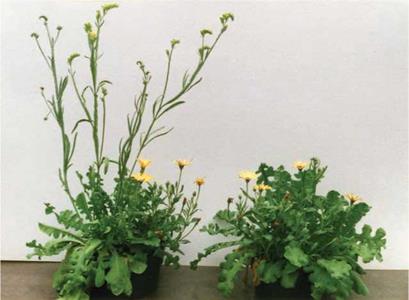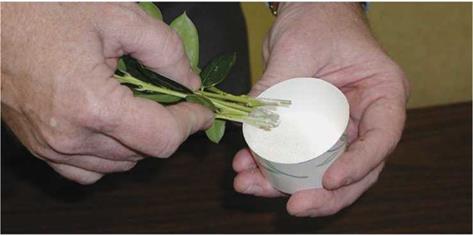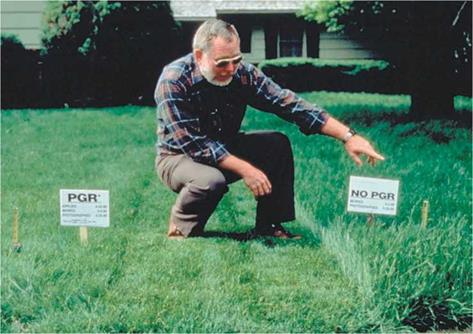Even without fully understanding the way growth regulators work, scientists have been able to synthesize products that influence the growth of plants in a similar manner. Many products of commercial importance
|
|
figure 4-9. Examples of growth retardants available for commercial use (Delmar/Cengage Learning. Photo by Jack Ingels)
are growth retardants and are used in the floriculture trade to produce shorter potted crops. Several are used by greenhouse and nursery propagators to promote rooting of cuttings (Figure 4-9). More recently, products have been developed that reduce the rate of growth of turfgrasses.
Under regular growing conditions, some greenhouse plants grow too tall to make desirable potted plants. Poinsettias, Easter lilies, chrysanthemums, and some hydrangeas can all get “leggy” if started too early or subjected to overly warm temperatures during the period of most rapid vegetative growth. The application of growth retardants to the plants helps to regulate their size (Figure 4-10). With potted azaleas, more flower buds can be induced and stem growth limited with the application of growth regulating chemicals.
|
|
figure 4-ю. The effect of growth regulators is illustrated dramatically in these results of a comparative study. The control plant on the left received no growth regulators. The plant on the right received sprays with growth retardant that has kept it shorter and fuller. (Delmar/Cengage Learning. Photo by Jack Ingels)
Table 4-1 lists the commercial growth retardants most commonly used by greenhouse growers and describes their effects.
In the nursery and florist trades, where vegetative cuttings are rooted, commercially available growth regulators are usually used to promote and accelerate root formation. The most popular root-promoting hormones are the auxins indoleacetic acid (IAA), indolebutyric acid (IBA), and napthaleneacetic acid (NAA). Applied as dusts or solutions to the ends of cuttings, the auxins can speed rooting time considerably, assuming other requirements for growth are not limited (Figure 4-11).
Where there is a large expanse of turfgrass, there is also a need to keep it mowed. In temperate zones, lawn areas may require mowing thirty or more times during a normal growing season. Often the terrain is sloping and difficult or dangerous to mow. With the application of growth retardants, turf growth can be restrained with a significant saving in the cost of fuel and labor normally required for mowing. Use of the retardants is wisely restricted to low-quality, minimum use, difficult-to-mow areas, since they often cause discoloration, thinning,
|
pt’ ]tr TABLE 4-1. |
Growth Retardants for Florist Crops |
|
|
Product Name |
Crop |
Effects |
|
A-Rest® |
Tulips |
Shortens stem length |
|
Chrysanthemums |
Shortens stem length |
|
|
Poinsettias |
Shortens stem length |
|
|
Easter lilies |
Shortens stem length |
|
|
B-Nine® |
Chrysanthemums |
Shortens stem length |
|
Poinsettias |
Shortens stem length |
|
|
Hydrangeas |
Shortens stem length |
|
|
Azaleas |
Shortens stem length and promotes heavier flower set |
|
|
Petunias |
Shortens stem length |
|
|
Cycocel® |
Poinsettias |
Shortens stem length |
|
Azaleas |
Shortens stem length and promotes heavier flower set |
|
|
Geraniums |
Shortens stem length |
|
|
Florel® |
Poinsettias |
Shortens stem length |
|
Carnations |
Promotes branching |
|
|
Roses |
Promotes new growth from base |
|
|
Phosfon® |
Chrysanthemums |
Shortens stem length |
|
Easter lilies |
Shortens stem length |
|
|
Bonzi® |
Poinsettias |
Shortens stem length |
|
Chrysanthemums |
Shortens stem length |
|
|
Pansies |
Shortens stem length |
|
|
Petunias |
Shortens stem length |
|
|
Easter lilies |
Shortens stem length |
|
|
figure 4-11. A stem cutting being dipped in auxin to promote rooting (Delmar/ Cengage Learning. Photo by Frank Flanders.)
|
pt’ f$’r TABLE 4-2. |
Growth Retardants for Turfgrasses |
|
|
Generic Name |
Product Name |
Effects |
|
Chloflurenol |
Maintain CF-125® |
Absorbed by foliage, carried upward and downward; inhibits or slows cell division |
|
Maleic hydrazide |
Chemform® De-Cut® Retard® Siesta® Slo-Gro® Super Sprout Stop® |
Absorbed by foliage, carried to areas of active growth, inhibits cell division in shoots, buds and roots |
|
Maleic hydrazide plus chloflurenol |
Posan® |
Absorbed by foliage, carried to areas of active growth; suppresses seedhead formation |
|
Mefluidide |
Embark® |
Absorbed by foliage; carried upward more than downward; suppresses growth and seedhead formation |
and reduced ability to recover from winter injury. The chemical regulators are often applied in combination with broad-leaved weed killers, since the retardants are often ineffective against many weeds. Table 4-2 describes the commercial growth retardants most commonly used by turf specialists.
Most of the turf growth regulators are applied twice each season, with six weeks or more between applications. Although the chemical products are not a substitute for mowing, they do save money (Figure 4-12).
|
|
figure 4-12. The growth retardant Embark 2-S® is seen to dramatically reduce the growth of turfgrass in this comparative trial. (pbi/Gordon Corporation)
SUMMARY______________________________________
Plant growth regulators are organic compounds that control the rate, direction, and nature of plant growth. Knowledge of plant growth regulators is incomplete; however, a great deal is known about auxins, gib – berellins, and cytokinins.
Auxins are hormones (naturally occurring growth regulators) that promote and inhibit plant growth. Indoleacetic acid (IAA) is the most commonly occurring natural auxin. Auxins occur in shoots and roots. In the shoots, they are responsible for apical dominance. They are also responsible for various tropisms in plants.
Gibberellins are hormones that promote cell division and enlargement in plants, often causing dramatic increases in plant height. Thirty or more gibberellins are known. They can overcome rosetting in plants, cause dormant seeds to germinate, and cause flowers to set fruit without pollination.
Cytokinins are also hormones. The best known is kinetin. Evidence indicates that the principle role of cytokinins is to accelerate cell division. In association with auxins, they may also promote cell enlargement. The initiation of roots and shoots and the overcoming of apical dominance have all been linked to the presence of cytokinins.
Each of the plant growth regulators can be identified by a distinctive diagnostic test. Even without fully understanding how these hormones work, scientists have been able to synthesize products that influence the growth of plants in a similar manner. The synthetic products are most frequently used either to retard the growth of florist crops that tend to get too tall or to promote branching or heavier flower set. They are also used to restrict the growth of turfgrass in low-quality, minimum-use, or difficult-to-mow areas.
ACHIEVEMENT REVIEW
![]()
A. SHORT ANSWER
1. Which of the following are characteristic of naturally occurring growth regulators?
a. organic compounds
b. inorganic compounds
c. present in plants in large amounts
d. present in plants in minute amounts
e. produced and active in the same plant part
f. produced in one part and active in another
2. List the diagnostic test that distinguishes each of the following growth regulators from others.
a. auxins
b. gibberellins
c. cytokinins
3. Which one or more of the three major growth regulators causes each of the following characteristic plant responses?
a. apical dominance
b. increased cell elongation
c. increased cell division
d. geotropism
e. parthenocarpy
f. phototropism
g. bolting
4. If you were a commercial horticulturist, which commercially produced growth
regulator(s) could you choose to solve the following problems?
a. vegetative cuttings need to be rooted quickly
b. potted poinsettias need to be kept short
c. carnations need their branching increased
d. Easter lilies need to be kept short
B. ESSAY EXPLANATIONS
Prepare short answer essay responses to explain the following.
1. A nursery grower tightly shears small plants being produced in containers. The explanation offered is that “the shearing will make them fuller and improve their sales appeal.” From the information given in this chapter, explain why shearing will make the small plants fuller.
2. A potted plant sitting on a window sill leans toward the sunlight. Why is that?
3. A greenhouse grower has experienced disappointing sales of his holiday crops. Customers complain that the Christmas poinsettias and the Easter lilies are too tall and leggy. What could the grower have done to improve customer satisfaction and increase sales?
![]()







